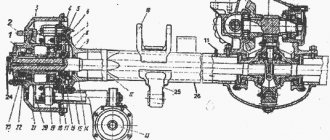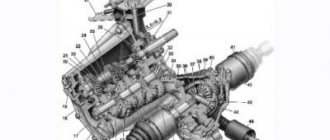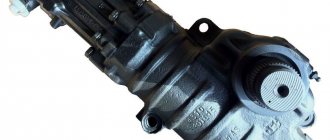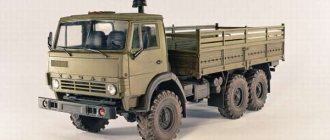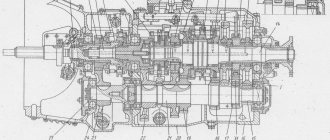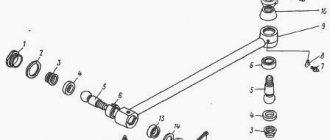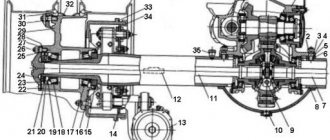Gearbox KAMAZ 43118 shift diagram
Gearbox on a Kamaz car (switching diagram) for subscribers
ZF gearbox on KamAZ 6520. Gear placement and shifting.
ZF Double H gearshift pattern
KAMAZ Evra 3 box
Gearbox on a Russian KAMAZ car
Roller Kamaz 2
ETS2 We register the actual travel of the gearshift lever
Starting, moving and stopping on a KAMAZ 4310 vehicle.
KAMAZ 43101 CONTROL-INSTRUMENTS
Kamaz 4310 Driving in Dosaaf
Also see:
- How to replace a filter drier on a KAMAZ
- Repair of the front axle gearbox KAMAZ 4310
- Checking KAMAZ scanmatic 2
- KAMAZ 740 on gas fuel
- Gur oil KAMAZ volume
- The reason for the failure of the KAMAZ engine
- KAMAZ handbrake diagram euro 3
- Knock in the KAMAZ engine when hot
- Brake drum KAMAZ 4326
- Oil volume in the KAMAZ gearbox
- Old tire from KAMAZ
- Bleeding fuel injection pump on KAMAZ
- Installation of abs system on KAMAZ
- KAMAZ light vehicles
- Tuning for KAMAZ
Home » New » Gearbox KAMAZ 43118 shift diagram
kamaz136.ru
_______________________________________________________________________________
Gearbox gearbox 154 Kamaz vehicles
The Kamaz 154 manual gearbox, ten-speed, is used for models 43118, 4350, 43505, 5350, 65115, 53605 and consists of a main gearbox, maximally unified with the 144 gearbox and a two-stage divider located in front of the main gearbox. Are used for cars with engines having a torque of up to 1100 Nm inclusive. The main difference from the Kamaz model 152 gearbox is the tapered bearings in the supports of the primary, intermediate and secondary shafts of the gearbox. Kamaz-154 gearbox configuration Designation: gearbox - 154.1700050 Clutch type, Kamaz clutch housing 17.1600010-01 (diaphragm), 17.1601008-10 Primary shaft cover - 14.1701039-40 (KAMAZ gearbox has clutch 17.1601180 ) Clutch release fork, fork shaft, lever fork shaft - 16.1601203, 14.1601215, 53215-1601217 for PGU 5320- 1609510 Designation of Kamaz 154 gearbox without divider - 154.1700150 Gear shift lever support - 530-1702200 side outlet Flange - 154.17 01240 with end splines (max. Ø180) Kamaz gearbox divider, input shaft divider - 154.1770010, 154.1770044 (splines 1 ¾ ') Primary shaft of gearbox 154, intermediate shaft of gearbox - 154.1701027 with clutch, 154.1701048 Bearing cover of secondary shaft - 154.1701201 Gearbox KamAZ-65115, 43118 (Gearbox 154) Ten-speed gearbox KamAZ 154 (Fig. 1) consists of a main five-speed gearbox 43 gears and a front two-stage gearbox divider 46 gears. The main five-speed gearbox of the Kamaz-154 consists of the following main components: a gearbox housing 41, in which the drive 5, driven 42 and intermediate 40 shafts assembled with gears, synchronizers and bearings are mounted; reverse gear block 21; top cover 25 of the box with gear shift mechanism assembly. A 46 gear divider is attached to the front end of the gearbox housing. The shaft bearings are closed with covers with sealing gaskets. The cover 10 of the rear bearing of the drive shaft is centered with an internal bore along the outer race of the bearing; The surface of the cover, machined along the outer diameter, is the centering surface for the divider housing. The cover 27 of the rear bearing of the driven shaft is attached to the rear end of the crankcase of the KPP-154 Kamaz and is centered on the outer race of the rear bearing 29 of the driven shaft. In the rear part of the cover there is a cuff 32 with a boot, on the working edge of which there is a left notch. In the bosses of the right wall of the Kamaz 154 gearbox housing, a boring is made into which axis 19 (Fig. 1) of the reverse gear unit is pressed. To prevent it from falling out, the axle is secured with a lock washer 24, screwed with a bolt 23, which has a drilling into which a plastic pin is inserted. The pin seals the threaded connection and prevents lubricant from leaking out. Oil in the 154 Kamaz gearbox is poured through the neck located on the right wall of the crankcase. The neck is closed with a plug with a built-in oil dipstick. At the bottom of the crankcase, a drain plug is screwed into the bosses; a magnet is built into the plug, which catches metal particles that may be in the oil. There are hatches on both sides of the crankcase for installing power take-offs. The hatches are closed with covers with sealing gaskets. The hatches are made in accordance with GOST 12323. The permissible power output is 22064, 97 W (30 hp) from each hatch. Power take-off while the vehicle is moving is not allowed. There is an oil pocket in the upper right part of the rear wall, into which oil is thrown by the rotation of the gears. From the oil pocket, oil flows through a drill in the crankcase wall into the cavity of the rear cover of the driven shaft to lubricate the worm pair of the speedometer drive. Gearbox gearboxes 154 Kamaz are assembled in pairs with mating gears in terms of contact patch and noise level.
Gearbox 154 Kamaz-65115, 43118 (Fig. 1) 1 - divider drive shaft; 2 — rear bearing cover of the divider drive shaft; 3, 9, 30 — adjusting gaskets; 4 — front roller bearing of the drive shaft; 5 — gearbox drive shaft; 6 — ring nut; 7 - washer; 8 — synchronizer clutch; 10 — rear bearing cover of the gearbox drive shaft; 11 — roller bearing; 18 — gear shift lever support; 19 — axis of the reverse gear block; 20 — thrust washers; 21 reverse gear blocks; 22 — roller bearing; 23 - bolt with pin; 24 — lock washer; 25 — top cover; 26 — sealing gaskets; 27 — cover of the rear bearing of the driven shaft; 29 — roller bearing of the rear driven shaft; 31 — speedometer drive worm; 32, 47 — sealing cuffs; 33 — flange mounting nut; 34 — driveshaft mounting flange; 36 — bearing cover; 37 - roller bearing; 40 - intermediate shaft; 41 — gearbox housing; 42 — driven shaft; 43 — main five-speed gearbox; 45 — sealing gasket; 46 — gear divider; 48 — clutch release fork; 49 - clutch release fork shaft. The drive shaft of the Kamaz 154 gearbox is made integral with the gear; its front support is a roller bearing, the outer ring 4 of which is pressed into the internal cavity of the shaft. The intermediate shaft is made integral with the rims of the gears of the first, second and reverse gears. At the front end of the shaft, gears 2 and 3 of the third and fourth gears and the intermediate shaft drive gear are pressed. A bearing is installed at the front end of the shaft, the outer race of which is installed in the drive shaft. All shaft gears are mounted on roller bearings, of which the fourth gear gear bearing is bulk, without a cage. The gears of the fourth and third gears of the 154 Kamaz gearbox are secured in the axial direction by a thrust ring with internal splines, which is installed in the shaft recess in such a way that its splines are located opposite the shaft splines, and is locked from rotation by a spring-loaded locking key. A channel is drilled along the shaft axis to supply lubricant through radial holes to the gear bearings. Oil is supplied to the channel by an oil injection device located on the drive shaft. For shockless shifting of the second, third, fourth and fifth gears there are two inertial-type finger synchronizers. The gearshift mechanism of the gearbox 154 Kamaz-65115, 43118 is mounted in the upper cover of the gearbox and consists of three rods, three shift forks, two rod heads, three clamps, a fuse for engaging first gear and reverse gear, as well as a rod lock. The rod lock consists of two pairs of balls and a pin. The balls are located between the rods in the bushings, the pin is located in the hole in the middle rod between the balls. The Kamaz 154 gearbox divider is a mechanical gearbox consisting of one pair of spur gears, drive and intermediate shafts, a synchronizer and a gear shift mechanism. The gear shift mechanism is controlled pneumatically. The axial travel of the drive shaft is controlled by a set of metal shims 0.2 and 0.3 mm thick, installed between the rear cover and the outer race of the ball bearing. At the end of the shaft, the involute splines for the finger synchronizer are divided into three crowns by two grooves. The teeth of the outer rings are thinner than the teeth of the middle ring to create a “lock” that prevents the gears in the divider from switching off on their own. The drive shaft gear of the 154 Kamaz gearbox rotates on two roller bearings. The oil injection ring supplies oil through inclined drillings of the drive shaft into its internal cavity, from where it enters the channels of the drive and driven shafts of the main KamAZ 154 gearbox. The intermediate shaft of the gearbox divider 154 Kamaz-65115, 43118 with a pressed-on drive gear of the intermediate shaft rotates on a double roller bearing . The Kamaz 154 gearbox divider switching mechanism is mounted on the divider housing on the left. The remote drive for controlling the Kamaz-154 gearbox consists of a swinging gear shift lever, a gear shift lever support mounted on the front end of the engine cylinder block, a rod and a reaction rod. The thrust fork is attached to the lever support via the bushing axis. The bushing is sealed with rubber rings. The axle is pinned onto a package of fastening parts for the gear shift lever support: studs screwed into the air pipe, vibration isolators, steel bushing; washers and nuts. The support for the gear shift lever of the gearbox 154 Kamaz-65115, 43118 consists of a bracket, a corrugated hatch seal, a seal spring, a shortened gear shift lever, which with its spherical part rests on a polyurethane bushing that dampens vibration of the lever. The sphere is pressed from above through a support washer by a spring. The Kamaz gearbox divider control valve 154, depending on the position of the spool, directs the air coming from the pressure reducing valve into one of the cavities under the air distributor pistons and moves the air distributor spool to one of the two extreme positions, thus preparing the air supply to the cavities of the power cylinder. Preliminary gear selection in the gearbox divider 154 Kamaz-65115, 43118 is made by moving the valve switch lever to one of two positions, which moves the valve spool through a braided cable.
_______________________________________________________________________________
_______________________________________________________________________________
_______________________________________________________________________________
- Clutch KamAZ-5320 and its components
- Repair of PGU and Kamaz clutch master cylinder
- Gearbox gearbox KamAZ 141
- Gearbox gearbox KamAZ ZF 16
- Gearbox 152 Kamaz with divider
- Gearbox gearbox 154 Kamaz
- Gearbox Kamaz-4308
- Clutch of a Kamaz-4308 car
- Clutch and gearbox KamAZ-65115
- Disassembly and assembly of Kamaz-4310, 55111, 43118 gearboxes
_______________________________________________________________________________
- Cylinder block, head and valves Kamaz-740
- Fuel system of Kamaz-740 diesel engine
- Adjustments and repairs of fuel injection pump Kamaz-740
- Drive axles of the Kamaz-4310 vehicle
- Repair of Kamaz drive axle gearbox
- Rear axle KamAZ-4308
- Axles and suspensions of Kamaz-65115 dump trucks
- Installation of Kamaz cardan shafts and axles
- Repair of Kamaz vehicle transfer case
- Kamaz power steering - adjustments and repairs
- Repair of Kamaz steering gear parts
- Steering parts Kamaz-4308
- Parts of the brake system Kamaz-4308
- Brake system and brake drive Kamaz
- Repair of brake valves and Kamaz compressor
- Suspension Kamaz-4310, 55111, 43118 and their parts
- Frame and suspension of the Kamaz-4308 car
- Cabin details and platform KamAZ-65115
- Cabin components Kamaz-4308
- Platform mechanism of Kamaz vehicles
- Klintsy KS 65719-5K truck crane based on KamAZ-6522 chassis
- Truck crane KC-35719-7-02 based on Kamaz-43118 chassis
- Truck crane Galichanin KC-55713-1K based on KamAZ-65115 6x4
- Ivanovets KS-45717K-1/1R truck crane based on KamAZ-65115 chassis
- Ivanovets KS-3577-3/4 truck crane on KamAZ-43253 4x2 chassis
KAMAZ 4310 gearbox control | KAMAZ
Gearbox on a Kamaz car (switching diagram) for subscribers
Design and maintenance of the KamAZ 4310 vehicle
Switching the transfer case of KamAZ 4310
Starting, moving and stopping on a KAMAZ 4310 vehicle.
KAMAZ 43101 CONTROL-INSTRUMENTS
Kamaz 4310 Driving in Dosaaf
How to properly use a divider on a Kamaz
Remaking the transfer case KAMAZ 4310 part 1 (my archive)
Everyday life of a Kamaz operator: controls, nothing to do, boring issue
Check inspection of the KAMAZ 4310 vehicle before departure.
Also see:
- Hand brake valve KAMAZ 5320
- Reviews about the KAMAZ 6522 car
- Pedal switch KAMAZ
- Assembled KAMAZ models
- Super tuning KAMAZ
- Models of KAMAZ master
- KAMAZ fuel tank volume
- KAMAZ speedometer winder
- Tires for KAMAZ trailer
- KAMAZ pump design
- Gear shift diagram on a KAMAZ dump truck
- Clutch KAMAZ 4310
- KAMAZ steering column disassembly
- Air purification filter KAMAZ dimensions
- Cabin frame KAMAZ 53212
Home » Collections » KAMAZ 4310 gearbox control
kamaz136.ru
Why is urea needed?
The AdBlue product is a special reagent used in all diesel engines that comply with Euro 4 and Euro 5 standards and include an SCR cleaning system. It is an aqueous solution of urea, which plays a major role in the catalytic neutralization process. Thanks to its use, it becomes possible to obtain environmentally friendly exhaust, extend the life of the engine and increase its efficiency.
Now let's talk about why urea is needed for trucks. Note that nowadays almost all trucks are equipped with SCR converters, due to which the performance characteristics of the vehicle itself and its engine increase, and engine elements receive protection from carbon deposits. Urea is poured into a tank specially designed for this purpose, located next to the car engine.
As a rule, the tank volume is 120 liters. The AdBlue product is quite economical and a larger volume will not be required. This volume is enough for a range of 8 thousand kilometers. The main principle of using this reagent is to strictly follow the attached instructions and use only the original product. It also matters how clean the tank into which the urea is poured is, and what materials it is made of.
Stages of exhaust gas purification
The high efficiency of the AdBlue product is based on 2 cycles.
At the 1st step, urea is injected into the stream of exhaust gases leaving the combustion chamber. Due to the high temperature, a chemical reaction is triggered, as a result of which urea is converted into ammonia. At the last, 2nd step, dangerous nitrogen oxides found in the exhaust gases, due to the influence of the catalyst and ammonia, go through an oxidation reaction and turn into ordinary water and nitrogen - familiar and safe substances. Here is a brief description of what urea does for diesel and why it is needed. Urea is used in diesel engines in order to achieve maximum compliance with exhaust gas purity to Euro-4, Euro-5 and Euro-6 standards. And thanks to the enormous cost-effectiveness of SCR technology, this product has gained great popularity among automobile companies around the world.
But for our country, this product is considered not the most suitable, since urea has certain disadvantages:
- You need to refill with additional AdBlue liquid, but it is not available everywhere in Russia, and its quality does not always meet the requirements. In this case, AdBlue consumption is equal to 5-7% of fuel consumption;
- This product freezes at a temperature of -11°C, so it is difficult to use in Russian winter conditions;
- Bad smell from the exhaust system;
- When a tank of AdBlue is heated, ammonia vapor appears, irritating the eyes, skin and mucous membranes;
- Toxicity of AdBlue, its ability to cause chemical burns when exposed to skin;
- There are too many fakes on the domestic market, so there is a high probability of system failure.
- In the end, these are unnecessary and considerable costs.
Pros and cons of using urea
A significant advantage, in addition to reducing emissions into the environment, is compliance with environmental standards. In civilized countries, the car owner is punished with monetary fines for non-compliance. Urea makes it possible to avoid them and at the same time take care of the environment.
As for the monetary costs of taking care of the environment, the price of urea is quite affordable. For car owners, a system using urea will not cost a pretty penny due to the low consumption of the component, which cannot be said about truck drivers. The latter are worth rejoicing at least because, thanks to urea, they are not forced to reduce engine capacity for the sake of the environment.
An interesting feature of the urea system is that it freezes at -12 degrees Celsius. This significantly limits the climatic scope of using such treatment systems - they simply will not work in cold climates.
The disadvantages also include the need to maintain the system and its components, which adds another expense item for car enthusiasts.
Why is urea needed for diesel?
Engineers are constantly looking for an answer to the question - how to reduce the amount of harmful emissions? Reducing engine volumes is unlikely to have a positive impact on the situation - people are too dependent on road transport, which allows us to deliver the goods we need by land. The carrying capacity of trucks will be reduced, resulting in the need to make several trips instead of one. An alternative way that can and should be used is to neutralize emissions from internal combustion engines.
Using an SCR catalyst and urea is one way to significantly reduce diesel engine emissions. Moreover, the component itself is absolutely harmless to humans and the environment. The system independently calculates the required amount of the component based on data on the current intensity of engine use. The greater the load, the more urea is injected into the SCR catalyst. Thus, the use of urea helps reduce harmful emissions.
Posts 121 page 150 of 179
1212013-11-01 14:54:19
Guys, please tell me. I want to take 65115, the mileage is not great - up to 100 km. I wanted to take it with a stone, but there is no winter heating of the body, and there is no information on how they have proven themselves (N-Chelnovsky). So I’m thinking, I’m wondering whether it’s with everything domestic, or somehow. Again, with what gear ratio of the main gear? The terrain is almost flat, the load is maximum. Who has any thoughts? Please share.
and you do it yourself according to the scheme of an old Kamaz from a muffler
1222013-11-01 14:55:36
Guys, please tell me. I want to take 65115, the mileage is not great - up to 100 km. I wanted to take it with a stone, but there is no winter heating of the body, and there is no information on how they have proven themselves (N-Chelnovsky). So I’m thinking, I’m wondering whether it’s with everything domestic, or somehow. Again, with what gear ratio of the main gear? The terrain is almost flat, the load is maximum. Who has any thoughts? Please share.
and you do it yourself according to the scheme of an old Kamaz from a muffler
gearbox ratio for 46 take
1232013-11-01 15:11:31
gearbox ratio for 46 take
I don’t recommend 46. They are very weak, but they come from the factory. At 47 they will be stronger and have enough speed.
1242013-11-01 20:32:17
and they are pushing Chinese, Brazilian and some other assembly -
Kamens have been assembled at Kamaz for two years now. This one costs 65117, mileage is 200 thousand. We replaced 1 injector and it started knocking.
1252013-11-01 20:34:39
I would advise taking the e-2 model
If you are satisfied with a used car.
1262013-11-01 20:44:17
In our country, the severity of the laws is compensated by the optionality of their implementation!) This is what I mean - even official dealers sell cars with Euro-1 engines) A completely new, factory car. And their conscience doesn’t even bother them))
1272013-11-01 21:47:19
I saw several “Chinese” cars in Khovo and Shanxi, where the car’s passport stated e-3. And when the cabin was raised, it was e-2.
1282013-11-01 23:10:57
I saw several “Chinese” cars in Khovo and Shanxi, where the car’s passport stated e-3. And when the cabin was raised, it was e-2.
Why look at the Chinese, it’s the same with us. Kamaz with engine 740.31 e2, and in documents e3
1292013-11-02 00:05:47
what about Euro-2 - I recently purchased a new one from a dealer with 740.13
1302013-11-02 15:42:55
Even in America, new engines are sold, without ecology. Americans take them and put them on their old cars, just so as not to mess with the USR. The whole world understands that ecology is shit. Send this Europe to where it rhymes!
1322013-12-10 20:42:27
Khabarovsk Kamaz driver wrote:
I would choose a Cummins. It has a service life of 1,000,000 km, but it also lasts for one and a half and, I heard, more. Just don’t take 8.5 liters. But, on the contrary, 11 liters. And you have to hurry, while they are Chinese, very good quality. When The Chinese do something under license, they do it well, unlike ours. It’s worth remembering ZF, the German ones NEVER break down! As soon as the Soviets put their hand in, all the forums are filled with problems with their operation. The same thing will happen with CUMMINS, stupid Americans don’t know , who they contacted. Our guys at one time bought Americans with killed CUMMINS11, went to China, rebuilt the engines with Chinese spare parts, they still drive and smile to this day. KAMAZ engines above E1, in my opinion, are too forced. In addition to the pump drive, the main bolts also tear and connecting rod caps. My friend’s fist of friendship came out because of this, and the starter flew off. It’s good that it was still under warranty, the block was replaced for nothing, but it was in the winter, they dragged it for 200 km, and it sat there for 2 days. Unpleasant. And one more thing he had already changed all the heads, they were burning! And he started changing them for the second round, and he wasn’t the only one, but the engine hadn’t gone through 200,000 yet. It’s not easy with a viscous coupling either. I drove an IVECO for a while, there was one like that. The thermostat opened and got stuck, but it The cold one spins the fan even better than the hot one. To let it go, it needs to warm up at least a little, in short, I couldn’t heat the engine above 20 degrees, I crashed an oak tree in the cabin (it’s only minus 20 outside). Oh, and I swore at the Germans!
but I bet I was driving once with Kamins and they were transporting about 20 tons each, and my total is more and every hill he died Kamaz Kamaz 300 gearbox ZF, though without a divider, my Kamaz 740 62 280 gearbox 154ya. And they began to suffer with the ZF gearboxes like the Chinese went (for example, on the basis of 6 65117, everyone with ZF has not yet been touched by a finger, they have covered 300 tons of km, but those familiar with Chinese units have not driven 50 tons, and they all say they work very noisily) and As for the heads, if they are on fire, it means his viscosity coupling is not working; two of us also suffered, then we found the reason, by the way, they have the original, no, they installed a non-original one, not even a new one worked. 740.62 280 is a good engine, but you can’t heat it up, so the heads and you can’t pull these engines; you can say goodbye to the shaft. I can say a lot about him - (740.62 280)
Engine repair
Maintenance of the Kamins internal combustion engine for Kamaz is carried out by analogy with the model 740 and its modifications. Although, according to the manufacturer's manual, maintenance should be done every 20,000 km, regardless of the condition of the parts. So, during maintenance it is necessary to perform the following series of operations:
- Changing the engine oil. At the same time, it is recommended to pour only high-quality American oil, which is indicated in the engine service book.
- Changing oil filters. Some engines are equipped with two engine oil filters: coarse and fine.
- Replacement of fuel filter elements: coarse and fine cleaning.
- Changing the air filter.
- As well as a number of diagnostic operations: diagnostics of the fuel system, measuring the compression of the power unit, checking the valve mechanism and others.
It is recommended to carry out repairs of engine components at a service station. But, often motorists think that we can repair it ourselves.
If you are guided by the technical documentation of the manufacturer, then all power units have a complex structure and their repair requires certain service equipment.
As for major repairs, they are performed extremely rarely, since the engine has a service life of 1,000,000 km. According to the technical documentation of the manufacturer, the motors are considered unrepairable, but in the CIS, such a concept does not exist and Cummins motors are still being repaired.
That is why spare parts such as pistons, crankshafts and valves are produced and supplied especially for the CIS countries. Of course, many spare parts have analogues that can be easily purchased on the automotive markets.
On-line repair of the Cummins KAMAZ engine can be carried out independently, since the engine has a simple and understandable design, which is why domestic motorists love it. But the repair of such elements as the fuel and oil pump is not something to joke about, since incorrectly set gaps can cause a lot of problems.
What is urea for diesel
Attempts to remove one of the components of exhaust gases lead to an increase in the content of the other.
If you try to get rid of soot in diesel exhaust, harmful nitrogen oxide will begin to go off scale and vice versa. Designers developed filters to combat soot, which began to be installed in the fuel system of diesel engines. To neutralize harmful nitrogen oxide, it was necessary to come up with a fundamentally new system involving the use of urea. Diesel urea, sold in car dealerships, is a liquid consisting of water and a chemical compound that decomposes into ammonia and carbon dioxide. The ammonia obtained from this mixture can be used to neutralize hazardous emissions. This process takes place in a special SCR catalyst.
Urea consumption depends on engine size, so trucks consume much more of the compound than cars. But, contrary to the negative expectations of motorists, the use and maintenance of such an exhaust gas purification system is relatively inexpensive, especially for passenger cars.
Malfunctions 43118 Euro-4
In addition to the ISB CM2150 ECU, KamAZ also installs Bosch MS 6.1, which belongs to the previous generation. A distinctive feature of this block is the two-digit blink codes for breakdowns. To turn on the diagnostic mode, you need to press the button under the steering wheel up or down for 2 seconds and wait until the check lamp starts flashing. The number of flashes with a long interval indicates the first digit of the code, and with a short interval - the second.
| Code | Designation |
| 9 | The EEPROM module is broken. Check the connection to the digital CAN bus. |
| 11 | The gas pedal is glitchy. |
| 12, 13 | Atmospheric pressure controller glitches. |
| 14 | Clutch failure. |
| 15 | Crankshaft glitch. |
| 16, 17 | Failure of frequency sensors. |
| 18 | Camshaft or sensor glitch. |
| 19 | The main relay requires replacement. |
| 21, 22, 24, 25, 26 | Fuel injection pump malfunction. |
| 23 | Glitches in the brake or gas pedals. |
| 27 | Broken steering rack. |
| 28 | Brake failure. |
| 29 | Control module failure. Causes:
|
| 31, 32 | Glitches of the incoming air temperature sensor. |
| 33, 34 | Air pressure controller glitches. |
| 35 | Cruise glitches. |
| 36, 37 | The motor cannot reach operating temperature. |
| 38, 39 | The fuel does not heat up. |
| 41 | Glitches due to the signal from the CAN bus input. |
| 42 | Reduce speed. |
| 43 | Speedometer glitches. |
| 51, 52, 53 | BU glitches. |
| 54 | Increased voltage in the network. |
| 55 | The engine block is faulty. |
| 61-67 | Failure of digital CAN bus controllers. |
| 84 | Speed controller glitch. |
| 97 | Glitches of the water in fuel controller. |
| 99 | Failures in the ECU. |
What is special about the Cummins muffler device on KamAZ vehicles?
From the very first day of its existence, the Kama Automobile Plant equipped trucks with engines of its own production. But in the mid-1990s, the first KAMAZ trucks with brand new American Cummins engines rolled off the production lines, and today they have taken a strong position in the market. Read about what the KAMAZ+Cummins combination is offering us now in this article.
How does urea work in diesel engines?
Typically, diesel vehicles use a combination of several cleaning systems. The particulate filter, as you might guess from its name, filters out oncologically dangerous soot. As for the liquid cleaning system using urea, it works in tandem with a special device - an SCR neutralizer. Special chemical compounds are applied to the walls of the latter, triggering the necessary chemical reactions.
For urea, a special tank and an injection device are installed on a diesel car, which is located in front of the SCR converter. In the exhaust system, urea and exhaust gases are mixed and end up in the SCR converter.
As a result, a series of chemical reactions occur that occur in the SCR under the influence of high temperature. First, urea (CH4N2O) reacts with water (H20) and decomposes to ammonia (NH3) and carbon dioxide (CO2).
Carbon dioxide is simply released into the atmosphere, but the ammonia obtained as a result of the first reaction reacts with nitrogen oxides and converts them into safer compounds, namely nitrogen and water.
- 4NO + 4NH3 + O2 → 4N2 + 6H2O
- 2NO2 + 4NH3 + O2 → 3N2 + 6H2O
- NO + NO2 + 2NH3 → 2N2 + 3H20
After such a multi-stage purification system, instead of hazardous substances that can cause serious illness in the long term, the output is nitrogen, water and inert gases - components that do not pose significant harm to humans, living beings and nature.
Factory and third-party installation of Cummins engines on KAMAZ trucks
Most KAMAZ vehicles with Cummins engines are produced on the assembly lines of the Kama Automobile Plant in Naberezhnye Chelny, but now there are a large number of companies offering services for installing American engines on early modifications of Kama trucks. However, in the vast majority of cases, engine replacement is carried out according to the recommendations of KAMAZ and Cummins, so such enterprises practically do not produce machines with non-standard equipment.
Third-party engine installation is an excellent option for upgrading trucks, which will result in improved vehicle performance at minimal cost.
KAMAZ and Cummins are a collaboration that has brought domestic trucks to a new level and given consumers the opportunity to choose high-quality and affordable equipment for various purposes.
Source of the article: https://arendavlg.com/kamaz/v-chem-osobennost-ustroystva-glushitelya-kamminz-cummins-na-mashinah-kamaz.html
Exhaust cleaning
With stricter regulations and standards for the environment, automakers have no choice but to bend over backwards and puzzle engineers on how to please the green ones without significantly increasing the cost of their cars.
Here Mercedes was the first to take the lead, having developed the Bluetec system, consisting of three elements at once - a particulate filter, a catalyst and a liquid neutralization system.
The last one is urea. A separate tank was designed and placed for it, into which AdBlue is poured. Water and ammonia are almost in pure form. Already from the tank, the system automatically injects this liquid into the exhaust gas system, where the latter are mixed with it and neutralized. This happens in the SCR
.
This is where pure chemistry comes into play. Ammonia from urea reacts with nitrogen oxides at a temperature of 300 degrees, resulting in water and nitrogen. Other chemical compounds simply burn out inside the system.
